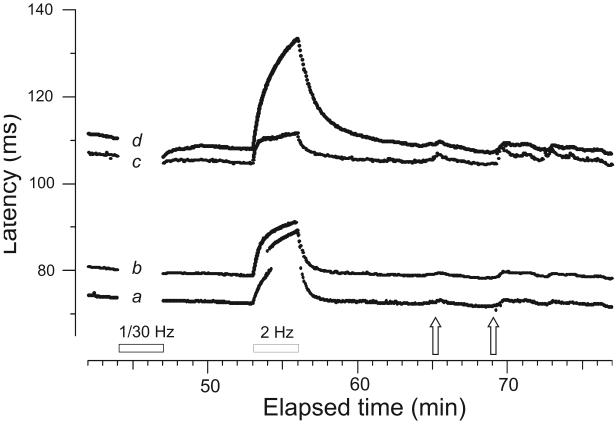Figure 1.
Simultaneous recording of sensory and sympathetic units from the left superficial peroneal nerve in a healthy 28 year-old female. Each line is made of the confluence of dots that each represent one evoked nerve action potential plotted at the intersection of conduction latency and elapsed time. The electrical stimulation protocol consisted of a 0.25 Hz baseline, followed by 3 min of 1 pulse per 30 s (1/30 Hz) (“pause”), then a 6-min return to 0.25 Hz baseline, a 3-min 2-Hz tetanus, and finally a 20-min period resuming 0.25 Hz stimulation for recovery of excitability and natural stimulus testing. Four units are shown with different latencies, classified according to their activity-dependent slowing profile as follows: (a) CMH; (b) CMH; (c) sympathetic unit; (d) MIA. The 2 CMHs (conducting 0.87 and 0.81 m.s−1, respectively), display a small latency effect after the pause (0.4 and 0.7% slowing, respectively) in comparison to the significant activity-dependent slowing (3.4%) of the MIA (conducting at a nominal velocity of 0.58 m.s−1). The sympathetic efferent (c) had an intermediate conduction velocity (0.61 m.s−1) and slowed by 1.1% following the pause. During the 2-Hz tetanus the CMHs and MIA (a,b,d) slowed by 18.6, 16%, and 23.7%, respectively, whereas the sympathetic efferent (c) slowed by only 6.2%. (The faster conducting CMH showed jumps to longer latency due to branch switching, resulting from threshold increase during the rapid electrical stimulation.) Mental stress (naming country capitals) (left open arrow), while causing a sudden latency increase reflecting a burst of impulse activity in the sympathetic efferent (c), was associated with a rather gradual increase in latency of CMHs and MIA, reflecting skin cooling. A similar, but more pronounced phenomenon was induced by a sudden loud startling noise (right open arrow).

